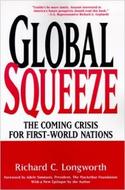Global Squeeze: The Coming Crisis for First-World Nations
Richard C. Longworth
McGraw-Hill 1998
Whenever we see the reality of momentous shifts in society, it’s always good to go back and take a look at the people who saw it coming far away. Generally speaking, there were usually people who understood what was happening in advance. For example, Daniel Bell wrote his book The Coming of Post-Industrial Society in 1976. There were probably even other earlier books touting the same theme. read more »





















